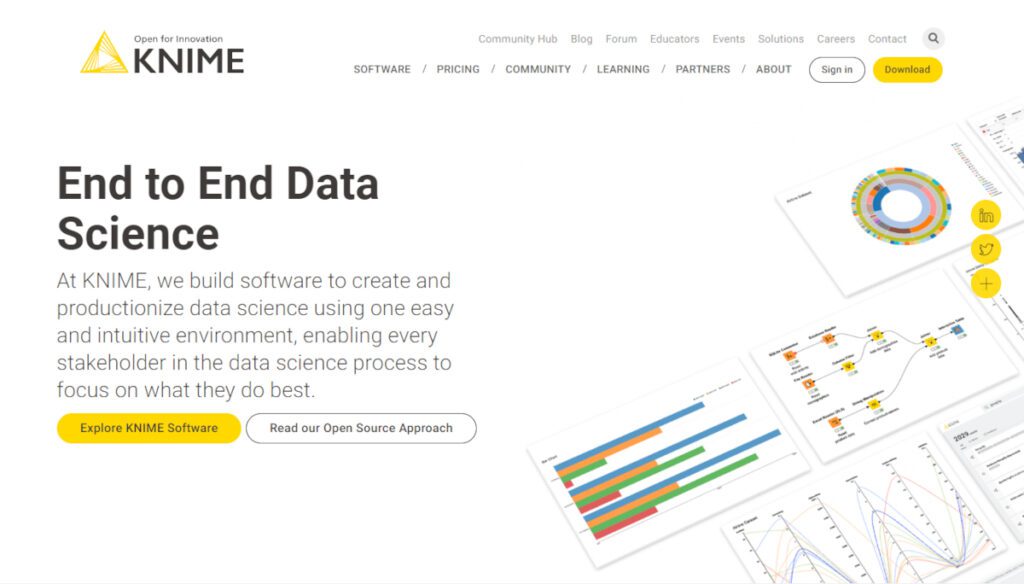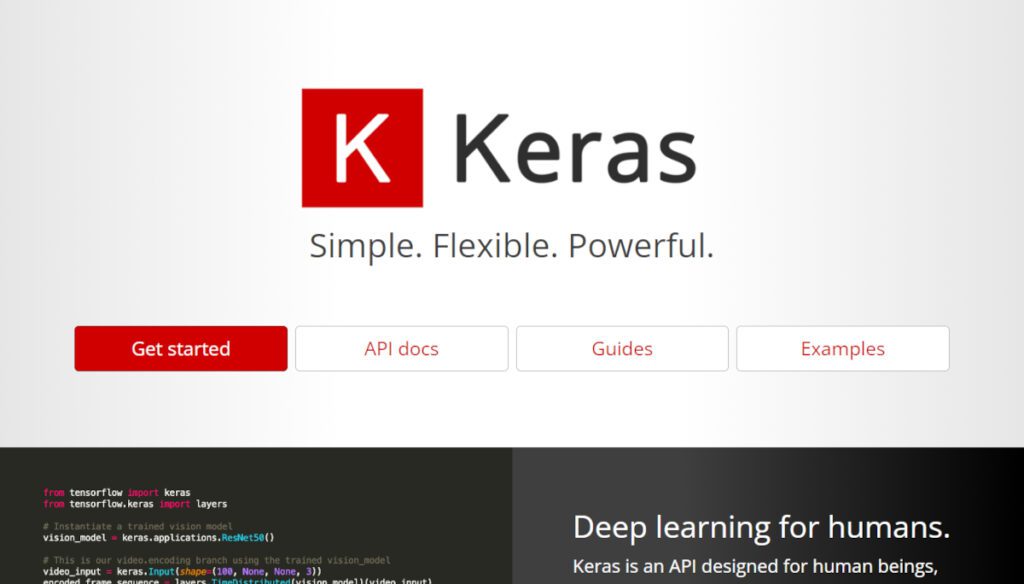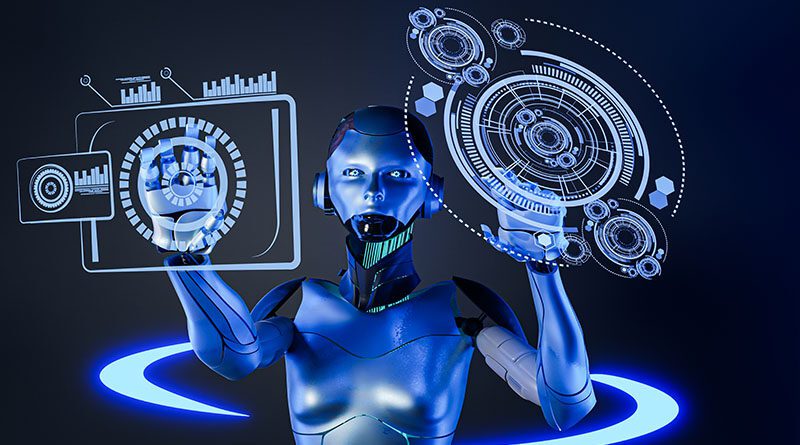10 Best Machine Learning Software
Machine Learning ML is a field of inquiry devoted to understanding and building methods that “learn”, methods that leverage data to improve performance on some set of tasks. It is seen as a part of artificial intelligence (according to Wikipedia).
Top 10 Software
What is the Best Machine Learning Software?
Many platforms rely heavily on ML in the services they provide, here is a list of the best of these platforms.
1. Cnvrg.io

Cnvrg.io is a Full Stack Machine Learning Operating System, cnvrg.io was built by data scientists, for data scientists to streamline the machine learning process, so they can focus less on grunt work and more on the real magic, algorithms.
Choose the best ML infrastructure for the job on demand:
– Run ML jobs where you can do them cheaper and faster.
– Mix and match infrastructure to your single end to end flow.
– Maximize workload performance and speed with the agility to run on any compute and storage.
– Connect your storage and compute to launch any AI workload on demand.
Leverage your entire AI ecosystem from one launch pad:
– Unify code, projects, models, repositories, compute, and storage all from one place.
– Gain control & visibility across all ML runs to improve utilization.
– Aggregate all your compute resources and leverage the best for the job.
– Orchestrate disparate AI infrastructures from one control panel.
– Explore freely with automated heterogeneous compute pipelines.
– Leverage your on premise and cloud resources with native Kubernetes cluster orchestration and meta-scheduler.
Deliver faster AI applications and results:
– Managed environment so you can focus on your AI workflow without technical complexity.
– Instantly build and deploy automated ML pipelines with any AI stack.
– Simplify engineering heavy tasks with MLOps and a container-based infrastructure.
– Seamlessly deploy and monitor your ML to any environment.
– Integrates into your IT stack in a few clicks.
Features:
– Hybrid & Multi Cloud: Leverage your on premise and cloud resources with native Kubernetes cluster orchestration and meta-scheduler
– Scalable: Enterprise-ready ML, built for rapid experimentation, reusable ML components, and production-ready infrastructure
– Collaborative: Unify data science teams with a clear and collaborative management environment. Build a repository of ML components for easy reproducibility.
– End to End: Automate, track and monitor your ML workflow from research to production
– Flexible: Use any language, AI framework, and compute environment. Integrate and version any kind of data to reuse in any project, experiment, and/or notebook
– Interactive: Use any development environment like JupyterLab, RStudio, and more with pre-installed dependencies and version control
2. Knime

Knime one of the Best Machine Learning Software, is an open source software with an intuitive, visual interface that lets you build analyses of any complexity level.
It takes a softer approach to machine learning automation. The guided automation—a special instance of guided analytics—makes use of a fully automated web application to guide users through the selection, training, testing, and optimization of a number of machine learning models. The workflow was designed for business analysts to easily create predictive analytics solutions by applying their domain knowledge.
How can KNIME Software Help in your Data Analysis?
CREATE
– Blend & Transform: Access, merge, and transform all of your data.
End to end data science starts with getting access to all of your data sources. KNIME Software allows you to connect to these varied data sources in one intuitive, visual workflow environment. Within this environment, a broad range of additional functionalities make data transformation, cleaning, and aggregating steps easy.
– Model & Visualize: Make sense of your data with the tools you choose.
Making sense of data requires sophisticated modeling and visualization techniques. Modern analytics now also encompasses machine learning and artificial intelligence. However, to solve certain problems, you still want to be able to reach out to the classic statistical analysis and data mining methods. Continually add both bleeding edge algorithms and well established analytics and visualization methods to KNIME Software. Together with R and Python integrations, plus integrations with other large, open source projects, you have the freedom to mix and match the tools you like, within one uniform environment.
PRODUCTIONIZE
– Deploy & Manage: Support enterprise-wide data science practices.
KNIME Software enables you to make best use of your people, time, and technology resources in order to meet the needs of both the team and the enterprise. It provides an environment which empowers your data science team to use the tools they know and to collaborate on complex projects. The deployment and management functionalities make it easy to productionize data science applications and services, and deliver usable, reliable, and reproducible insights for the business.
– Consume & Interact: Leverage insights gained from your data.
You know data science provides value but don’t want to wait weeks to receive only half relevant insights. Furthermore, you want to be able to quickly influence the data and methods used and the application and services provided. KNIME Software brings you into the data science cycle so you can provide feedback and ensure the data science process immediately reflects changing requirements or new insights.
3. Keras

Keras is an API designed for human beings, not machines. Keras follows best practices for reducing cognitive load: it offers consistent & simple APIs, it minimizes the number of user actions required for common use cases, and it provides clear & actionable error messages. It also has extensive documentation and developer guides.
The Keras project isn’t limited to the core Keras API for building and training neural networks. It spans a wide range of related initiatives that cover every step of the machine learning workflow.
KerasTuner is an easy-to-use, scalable hyperparameter optimization framework that solves the pain points of hyperparameter search. Easily configure your search space with a define-by-run syntax, then leverage one of the available search algorithms to find the best hyperparameter values for your models. KerasTuner comes with Bayesian Optimization, Hyperband, and Random Search algorithms built-in, and is also designed to be easy for researchers to extend in order to experiment with new search algorithms.
KerasNLP is a natural language processing library that supports users through their entire development cycle. The workflows are built from modular components that have state-of-the-art preset weights and architectures when used out-of-the-box and are easily customizable when more control is needed. Emphasize in-graph computation for all workflows so that developers can expect easy productionization using the TensorFlow ecosystem.
Iterate at the speed of thought, Keras is the most used deep learning framework among top-5 winning teams on Kaggle. Because Keras makes it easier to run new experiments, it empowers you to try more ideas than your competition, faster. And this is how you win.
Exascale machine learning, built on top of TensorFlow 2, Keras is an industry-strength framework that can scale to large clusters of GPUs or an entire TPU pod. It’s not only possible; it’s easy.
Deploy anywhere, take advantage of the full deployment capabilities of the TensorFlow platform. You can export Keras models to JavaScript to run directly in the browser, to TF Lite to run on iOS, Android, and embedded devices. It’s also easy to serve Keras models as via a web API.
A vast ecosystem, Keras is a central part of the tightly-connected TensorFlow 2 ecosystem, covering every step of the machine learning workflow, from data management to hyperparameter training to deployment solutions.
State-of-the-art research, Keras is used by CERN, NASA, NIH, and many more scientific organizations around the world (and yes, Keras is used at the LHC). Keras has the low-level flexibility to implement arbitrary research ideas while offering optional high-level convenience features to speed up experimentation cycles.
An accessible superpower, because of its ease-of-use and focus on user experience, Keras is the deep learning solution of choice for many university courses. It is widely recommended as one of the best ways to learn deep learning.
4. Anaconda

Anaconda Number 04 in our list of the Best Machine Learning Software, it offers the easiest way to perform Python / R data science and machine learning on a single machine. Start working with thousands of open-source packages and libraries today. It empowers people with data literacy, so they can ask better questions and make better sense of the world.
They make software to enable corporations and other organizations to put open-source data science to work with the right security, scale, and governance in place. The Professional Services team helps organizations solve their unique challenges when it comes to operationalizing data science in their environment.
Not just point solutions and powerful solving, Anaconda was built by data scientists, for data scientists. More than 20 million people use this technology to solve the toughest problems.
The modern world of data science is incredibly dynamic. Every day, new challenges surface and so do incredible innovations. To win in this context, organizations need to give their teams the most versatile, powerful data science and machine learning technology so they can innovate fast without sacrificing security and governance.
Why it matters:
– Deliver on your data strategy
– Get to market faster
– Maximize flexibility and control
– Attract and keep the best talent
Using Anaconda:
– Tackle any challenge
Anaconda solutions are serious technology for real data science and ML applications. Anaconda is versatile – you’ll be ready to solve problems you don’t even know you have yet.
– Own your destiny
Your business challenges change every day. Only open-source innovation can keep pace with your needs. Never be stuck waiting for a vendor to add a feature again.
– Stay safe and secure
Catch vulnerabilities before they catch you. Control access to models, data, and packages. Know the who, what, when, and where of every project.
5. H2O.ai

At H2O.ai, democratizing AI isn’t just an idea, it’s a movement. And that means that it requires action. It started out as a group of like minded individuals in the open source community, collectively driven by the idea that there should be freedom around the creation and use of AI.
Today it has evolved into a global company built by people from a variety of different backgrounds and skill sets, all driven to be part of something greater than ourselves. The partnerships now extend beyond the open-source community to include business customers, academia, and non-profit organizations.
H2O is a fully open source, distributed in-memory machine learning platform with linear scalability. H2O supports the most widely used statistical & machine learning algorithms including gradient boosted machines, generalized linear models, deep learning and more. H2O also has an industry leading AutoML functionality that automatically runs through all the algorithms and their hyperparameters to produce a leaderboard of the best models. The H2O platform is used by over 18,000 organizations globally and is extremely popular in both the R & Python communities.
Key Features of H2O:
– Leading Algorithms
Algorithms developed from the ground up for distributed computing and for both supervised and unsupervised approaches including Random Forest, GLM, GBM, XGBoost, GLRM, Word2Vec and many more.
– Access from R, Python, Flow and more…
Use the programing language you already know like R, Python and others to build models in H2O, or use H2O Flow, a graphical notebook based interactive user interface that does not require any coding.
– AutoML
H2O’s AutoML can be used for automating the machine learning workflow, which includes automatic training and tuning of many models within a user-specified time limit. Stacked Ensembles will be automatically trained on collections of individual models to produce highly predictive ensemble models which, in most cases, will be the top performing models in the AutoML Leaderboard.
– Distributed, In-Memory Processing
In-memory processing with fast serialization between nodes and clusters to support massive datasets. Distributed processing on big data delivers speeds up to 100x faster with fine-grain parallelism, enabling optimal efficiency without introducing degradation in computational accuracy.
– Simple Deployment
Easy to deploy POJOs and MOJOs to deploy models for fast and accurate scoring in any environment, including very large models.
6. Google Cloud

Google Cloud offers a number of innovative machine learning products, solutions, and applications on a trusted cloud platform that enables businesses to easily build and implement machine learning algorithms and models.
By using products like AI Hub, AI Platform, and AI building blocks, organizations can make sense of all the data they’re producing, collecting, or otherwise inquiring, no matter what format it’s in, to make actionable business decisions.
Related products and services:
– Vertex AI
Build, deploy, and scale machine learning (ML) models faster, with fully managed ML tools for any use case. New customers get free credits to spend on Vertex AI.
Accelerate ML with a unified data and AI platform and tooling for pre-trained and custom models
Implement MLOps practices to efficiently scale, manage, monitor, and govern your ML workloads
Reduce training time and costs with optimized infrastructure
– AI building blocks
Easily infuse AI into your existing applications or build entirely new intelligent applications across a broad spectrum of use cases.
– AI Infrastructure
Options for every business to train deep learning and machine learning models cost-effectively.
– Cloud TPU
Train and run machine learning models faster than ever before.
– Contact Center AI
Deliver exceptional customer service and increase operational efficiency using artificial intelligence. Enable your virtual agent to converse naturally with customers and expertly assist human agents on complex cases.
– Build and use AI
Infuse AI into workflows regardless of your level of expertise. Accelerate time to market with AI solutions and AI building blocks, and use AI Platform to simplify building, deploying, and managing models at scale.
– Document AI
Unlock insights from documents with machine learning. Tap into the opportunity offered by your unstructured data to increase operational efficiency, improve customer experience, and inform decision-making.
7. Scikit learn

Scikit learn is a free software machine learning library for the Python programming language. It features various classification, regression and clustering algorithms including support-vector machines, random forests, gradient boosting, k-means and DBSCAN, and is designed to interoperate with the Python numerical and scientific libraries NumPy and SciPy. Scikit-learn is a NumFOCUS fiscally sponsored project.
There are multiple scikits, which are scientific toolboxes built around SciPy. Apart from scikit-learn, another popular one is scikit-image.
scikit-learn is regularly tested and maintained to work with PyPy (an alternative Python implementation with a built-in just-in-time compiler).
Note however that this support is still considered experimental and specific components might behave slightly differently.
Scikit-learn is built on NumPy, SciPy, and matplotlib. Open source, commercially usable – BSD license, ccessible to everybody, and reusable in various contexts.
Examples that illustrate the main features of the releases of scikit-learn:
– Biclustering
– Calibration
– Classification
– Clustering
– Covariance estimation
– Cross decomposition
– Dataset examples
– Decision Trees
– Decomposition
– Ensemble methods
8. PyTorch

PyTorch is an optimized tensor library for deep learning using GPUs and CPUs, an open source machine learning framework that accelerates the path from research prototyping to production deployment. It enables fast, flexible experimentation and efficient production through a user-friendly front-end, distributed training, and ecosystem of tools and libraries.
Get up and running with PyTorch quickly through popular cloud platforms and machine learning services.
Key features and capabilities:
– PRODUCTION READY
With TorchScript, PyTorch provides ease-of-use and flexibility in eager mode, while seamlessly transitioning to graph mode for speed, optimization, and functionality in C++ runtime environments.
– TORCHSERVE
TorchServe is an easy to use tool for deploying PyTorch models at scale. It is cloud and environment agnostic and supports features such as multi-model serving, logging, metrics and the creation of RESTful endpoints for application integration.
– DISTRIBUTED TRAINING
Optimize performance in both research and production by taking advantage of native support for asynchronous execution of collective operations and peer-to-peer communication that is accessible from Python and C++.
– MOBILE (EXPERIMENTAL)
PyTorch supports an end-to-end workflow from Python to deployment on iOS and Android. It extends the PyTorch API to cover common preprocessing and integration tasks needed for incorporating ML in mobile applications.
– ROBUST ECOSYSTEM
An active community of researchers and developers have built a rich ecosystem of tools and libraries for extending PyTorch and supporting development in areas from computer vision to reinforcement learning.
– NATIVE ONNX SUPPORT
Export models in the standard ONNX (Open Neural Network Exchange) format for direct access to ONNX-compatible platforms, runtimes, visualizers, and more.
– C++ FRONT-END
The C++ frontend is a pure C++ interface to PyTorch that follows the design and architecture of the established Python frontend. It is intended to enable research in high performance, low latency and bare metal C++ applications.
– CLOUD SUPPORT
PyTorch is well supported on major cloud platforms, providing frictionless development and easy scaling through prebuilt images, large scale training on GPUs, ability to run models in a production scale environment, and more.
9. TensorFlow

TensorFlow is an end-to-end platform that makes it easy for you to build and deploy ML models. TensorFlow offers multiple levels of abstraction so you can choose the right one for your needs. Build and train models by using the high-level Keras API, which makes getting started with TensorFlow and machine learning easy.
If you need more flexibility, eager execution allows for immediate iteration and intuitive debugging. For large ML training tasks, use the Distribution Strategy API for distributed training on different hardware configurations without changing the model definition.
– Robust ML production anywhere
TensorFlow has always provided a direct path to production. Whether it’s on servers, edge devices, or the web, TensorFlow lets you train and deploy your model easily, no matter what language or platform you use.
Use TFX if you need a full production ML pipeline. For running inference on mobile and edge devices, use TensorFlow Lite. Train and deploy models in JavaScript environments using TensorFlow.js.
– Powerful experimentation for research
Build and train state-of-the-art models without sacrificing speed or performance. TensorFlow gives you the flexibility and control with features like the Keras Functional API and Model Subclassing API for creation of complex topologies. For easy prototyping and fast debugging, use eager execution.
TensorFlow also supports an ecosystem of powerful add-on libraries and models to experiment with, including Ragged Tensors, TensorFlow Probability, Tensor2Tensor and BERT.
– Engage users with personalized recommendations
From video on demand to ecommerce, recommendation systems power some of the most popular apps today. Learn how to build recommendation engines using state-of-the-art algorithms, hardware acceleration, and privacy-preserving techniques with resources from TensorFlow and the broader community.
– Run TensorFlow models in Android, iOS, and Web apps
Unlock new experiences like real-time body segmentation with on-device ML. Explore ready-to-use and customizable solutions for vision, NLP, audio, and other common use cases.
– Improve MLOps productivity with TFX pipelines
Discover the ways the community-based traffic and navigation app Waze uses TFX and the power of its built-in components to build ML pipelines on Google Cloud.
10. Waikato

Waikato has incorporated several standard ML techniques into a software “workbench” called Weka, for Waikato Environment for Knowledge Analysis. With it, a specialist in a particular field is able to use ML to derive useful knowledge from databases that are far too large to be analysed by hand. Weka’s users are ML researchers and industrial scientists, but it is also widely used for teaching. Recently, the same team has also worked on MOA, an environment for mining data streams.
Weka is a collection of machine learning algorithms for data mining tasks. It contains tools for data preparation, classification, regression, clustering, association rules mining, and visualization.
Weka is open source software issued under the GNU General Public License. Several free online courses are to teach machine learning and data mining using Weka. The videos for the courses are available on Youtube. Weka supports deep learning.
Project objectives are to:
– Make ML techniques generally available;
– Apply them to practical problems that matter to New Zealand industry;
– Develop new machine learning algorithms and give them to the world;
– Contribute to a theoretical framework for the field.
Conclusion
To choose your Machine Learning platform, you can follow some indicators. If you want a proprietary or open source platform, with all the advantages that each of them offers. If you need a user-friendly interface with full control over the data, you can compare how every platform’s interface is and what fonctioanlity it has.





